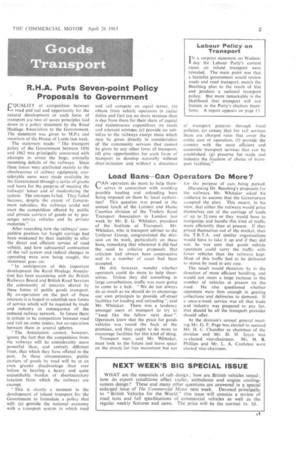R.H.A. Puts Seven-point Policy Proposals to Government
Page 7

If you've noticed an error in this article please click here to report it so we can fix it.
QUALITY of competition between
road and rail and opportunity for the natural development of each form of transport are two of seven principles laid down in a policy statement by the Road Haulage Association to the Government The statement was given to M.P.s and members of the House of Lords last week.
The statement rcads: "The transport policy of the Government between 1956 and 1962 was principally concerned with attempts to arrest the huge, annually mounting deficits of the railways. Since these losses were attributed mainly to the obsolescence of railway equipment, considerable sums were made available by the Government through a series of grants and loans for the purpose of meeting the railways' losses and of modernizing the system. The attempts failed. They failed because, despite the extent of Government subsidies, the railways could not meet the competition offered by public and private carriers of goods or by passenger service vehicles and by private motorists ".
After recording how the railways' competitive position for freight carriage had been weakened by their inability to offer the direct and efficient service of road vehicle, and how substantial contraction of the rail system and radical changes in operating were now being sought, the statement goes on: " In anticipation of this important development the Road Haulage Association has been examining with the British Railways Board and British Road Services the community of interests shared by these forms of public goods transport. By co-operation on the part of these interests it is hoped to establish new forms of service which will be required by trade and industry in consequence of the reduced railway network. In future there is certain to be competition between road and rail on some routes, but co-operation between them in several spheres.
The Association cannot, however, ignore the fact that the competition from the railways will be considerably more powerful than, and entirely different from, that which they have offered in the past. In these circumstances, public carriers of goods by road will be at an even greater disadvantage than ever before in bearing a heavy and quite unjustifiable burden of discriminatory taxation from which the railways are exempt.
"This is clearly a moment in the development of inland transport for the Government to formulate a policy that will: (a) provide the national economy with a transport system in which road and rail compete on equal terms; (b) obtain from vehicle operators in excise duties and fuel tax nn more revenue than is due from them for their share of capital and maintenance expenditure on roads and relevant servioes; (c) provide no subsidies to the railways except those which may be given directly in consideration of the community services that cannot be given by any other form of transport; (d) give opportunities for each form of transport to develop naturally without discrimination and without a distortion of transport patterns through fiscal policies; (c) ensure that for rail services there are charged rates that cover the entire cost of operation; (f) provide the country with the most efficient and economic transport services that can be established; (g) preserve for trade and industry the freedom of choice of transport facilities."












































































































